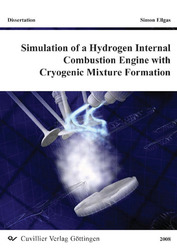| Areas | |
|---|---|
| Serie de libros (96) |
1378
|
| Nachhaltigkeit |
3
|
| Gesundheitswesen |
1
|
| Letra |
2364
|
| Ciencias Naturales |
5406
|
| Ciencias Ingeniería |
1793
|
| Ingeniería | 292 |
| Ingeniería mecánica y de proceso | 862 |
| Ingeniería eléctrica | 686 |
| Mineria y metalurgía | 30 |
| Arquitectura e ingeniería civil | 75 |
| General |
98
|
|
Leitlinien Unfallchirurgie
5. Auflage bestellen |
|
Erweiterte Suche
Simulation of a Hydrogen Internal Combustion Engine with Cryogenic Mixture Formation (Tienda española)
Simon Ellgas (Autor)Previo
Indice, Datei (61 KB)
Lectura de prueba, Datei (210 KB)
It is generally accepted that the worldwide change of the climate is caused by the manmade emissions of the greenhouse gas CO2. For this reason the development of new technologies for propulsion aims at the reduction of the CO2-emissions. Using hydrogen as an energy carrier offers the possibility to produce the fuel for vehicles from renewable energy sources, thus avoiding the emission of CO2 completely. The on-board storage of liquid hydrogen at very low(cryogenic) temperatures offers currently the best basis to achieve acceptable cruising ranges of hydrogen vehicles. The consistent utilisation of the cold hydrogen using cryogenic mixture formation offers unique opportunities for the optimisation of a combustion engine with regard to power and efficiency.
To fully exploit the potential of this promising mixture formation strategy, the usage of modern simulation techniques is necessary. In the course of this thesis, 1D and 3D computational fluid dynamic simulation tools were brought to a serviceable state ready for the optimisation of a hydrogen engine with cryogenic mixture formation. The simulation of the mixing and the combustion with novel models, adapted for hydrogen engine simulations, was verified by comparison to engine test bench results and optical experiments. Careful model and mesh studies have been performed. The ability of a Turbulent Flame Speed Closure (TFC) combustion model to predict the combustion process for a large part of the engine operating map could be demonstrated. This is a significant progress compared to results achieved until now regarding hydrogen engine simulations.
A crucial point of the cryogenic mixture formation is the formation of frost inside the intake port due to the low mixture temperature. For the simulation of this phenomenon, a novel approach to compute frost formation in combination with a 3D CFD simulation has been developed. The validity of the model could be demonstrated on the basis of experimental results reported in literature and by comparison to preexisting cryogenic hydrogen injection experiments. The innovative simulation tool could be applied developing suggestions how to avoid the undesired formation of frost. A simple but robust solution for the frosting issue was elaborated, whose functionality could be demonstrated during engine operation at the test bench, which is regarded as an essential step towards the realisation of a hydrogen engine with cryogenic mixture formation.
The presented thesis was conducted at BMW Group Research and Technology in the course of the European funded project HyICE – Optimisation of a Hydrogen Powered Internal Combustion Engine.
| ISBN-10 (Impresion) | 3867275297 |
| ISBN-13 (Impresion) | 9783867275293 |
| ISBN-13 (E-Book) | 9783736925298 |
| Formato | A5 |
| Idioma | Inglés |
| Numero de paginas | 182 |
| Edicion | 1 |
| Volumen | 0 |
| Lugar de publicacion | Göttingen |
| Lugar de la disertacion | München |
| Fecha de publicacion | 25.02.2008 |
| Clasificacion simple | Tesis doctoral |
| Area |
Ingeniería
Ingeniería mecánica y de proceso |








